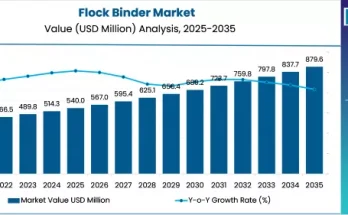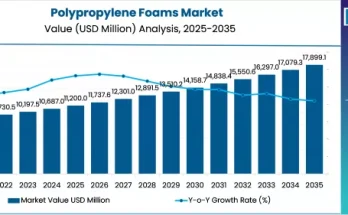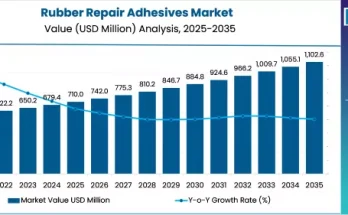The global microfluidic blends market is expected to reach USD 611.1 million by 2035, up from USD 316.5 million in 2025. During the forecast period from 2025 to 2035, the industry is projected to expand at a CAGR of 6.8%. This growth reflects the increasing adoption of microfluidic solutions across pharmaceuticals, biotechnology, diagnostics, and advanced healthcare applications. The market is also benefiting from greater interest in lab-on-a-chip diagnostics, personalized medicine, and wearable biosensors. Microfluidic blends offer unmatched precision, chemical compatibility, and biocompatibility, making them an essential part of the next wave of innovation in life sciences and industrial applications.
Microfluidic Blends Market Analysis
The microfluidic blends market can be examined through multiple lenses. By material type, the market includes thermoplastics, elastomers, glass, paper, silicon, and composites. Thermoplastics are expected to retain a dominant position in the near term, while silicon is forecast to see significant growth due to its unique properties and compatibility with emerging fabrication techniques.
In terms of blend composition, the market spans polymer–polymer, polymer–nanoparticle, polymer–bioactive compound, and hybrid blends. Each of these compositions provides varying levels of performance, from mechanical strength and durability to enhanced bioactivity.
When considering fabrication techniques, the market is supported by advances in soft lithography, injection molding, hot embossing, laser micromachining, 3D printing, and micro-milling. These methods are enabling scalable production while maintaining the precision needed for sensitive applications in healthcare and biotechnology.
Applications for microfluidic blends are diverse. They are widely used in drug-delivery systems, diagnostic devices, lab-on-a-chip platforms, cell culture models, organ-on-chip technologies, and microreactors. Each application area continues to evolve rapidly, driving demand for more reliable and versatile materials.
The end-use industries for microfluidic blends include pharmaceuticals and biotechnology, healthcare and diagnostics, chemical processing, food and beverage testing, as well as academic and research institutions. The breadth of demand ensures the market maintains momentum across multiple sectors.
Regionally, growth is being observed worldwide, with North America, Europe, East Asia, and South Asia & Pacific leading adoption. Markets in China, the United States, and Japan are particularly noteworthy, registering some of the fastest growth rates during the forecast period.
Highlighting Recent Developments
Recent years have seen notable innovation in the microfluidic blends market. Companies are increasingly investing in product development, collaborations, and new fabrication technologies. For instance, the introduction of borosilicate glass micromixers has expanded possibilities for precise mixing of solvents and reagents in pharmaceutical environments. These devices offer transparency and chemical resistance, making them highly valuable for lipid nanoparticle and liposome research.
Another significant development has been the partnership between material science firms and microfluidic specialists. Collaborations that integrate advanced fluoropolymer formulations into microfluidic blends have enhanced droplet stability, improved performance in diagnostics, and advanced capabilities in applications such as PCR analysis and cancer detection. These partnerships highlight the growing role of strategic alliances in pushing the boundaries of microfluidic technology.
Sustainability has also become an important theme in recent developments. Companies are increasingly focusing on recyclable materials, solvent-free processing, and eco-friendly blends. This aligns with the global push for greener technologies while also meeting regulatory requirements.
Competitive Dynamics and Regional Growth Patterns
The microfluidic blends market is highly competitive, with several leading players shaping its trajectory. Firms specializing in microfluidics, such as Micronit Microtechnologies, Dolomite Bio, and uFluidix, are constantly introducing innovative solutions that enhance precision and adaptability. Other established players, including IDEX Health & Science, microfluidic ChipShop, Suzhou Wenhao, and Elvesys Group, are maintaining strong positions through diversified portfolios and consistent R&D investments.
Competition is intensifying not only around product performance but also around fabrication techniques. Many companies are striving to integrate microfluidics with scalable and cost-effective production methods like 3D printing and injection molding. This is helping to expand commercial adoption beyond laboratories and into broader healthcare and industrial settings.
Regionally, China is emerging as the fastest-growing market, benefiting from a strong base of manufacturing expertise and rising investments in biotechnology. The United States remains a key hub for innovation, particularly in diagnostics and personalized medicine, while Japan is leveraging advancements in precision engineering to strengthen its position. Europe, too, continues to contribute with a strong focus on research and collaboration between academic institutions and private firms.
Competitor Analysis
The landscape of competition in the microfluidic blends market is defined by both established companies and emerging innovators. IDEX Health & Science remains a central player, offering a wide range of solutions for microfluidic applications. Micronit Microtechnologies has stood out with its recent introduction of advanced micromixer technologies tailored for pharmaceutical applications. Dolomite Bio continues to push boundaries in single-cell analysis and organ-on-chip systems, while microfluidic ChipShop and uFluidix maintain competitive strength with versatile offerings for research and diagnostics.
In addition, new collaborations are reshaping the competitive environment. The partnership between Syensqo and Emulseo, for example, demonstrates how strategic alliances can generate breakthrough formulations that improve performance in droplet-based diagnostics. Such moves highlight the increasing emphasis on material science as a key differentiator in the market.



